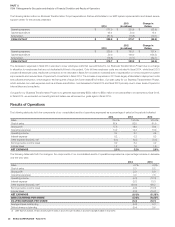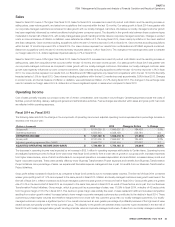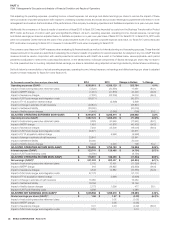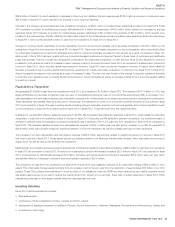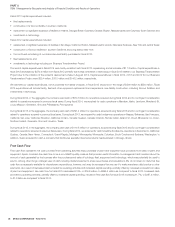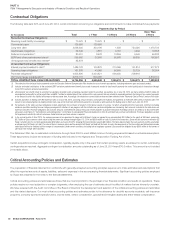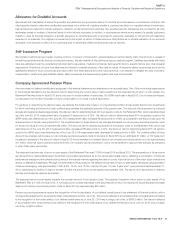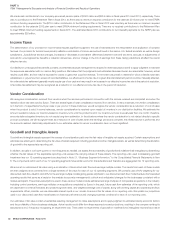Sysco 2014 Annual Report Download - page 44
Download and view the complete annual report
Please find page 44 of the 2014 Sysco annual report below. You can navigate through the pages in the report by either clicking on the pages listed below, or by using the keyword search tool below to find specific information within the annual report.SYSCO CORPORATION-Form10-K32
PARTII
ITEM7Management’s Discussion and Analysis ofFinancial Condition and Results of Operations
in scal 2013 that were in service in scal 2014. These increases were partially offset by reduced sales and information technology pay-related expenses.
Retirement-related costs decreased primarily from the plan freezes that occurred in scal 2013. Our expense on a cost per case basis decreased as
compared to scal 2013 primarily from reduced pay-related expenses from our sales and information technology areas and lower retirement-related
expenses, partially offset by increased costs from delivery pay-related expenses.
Fiscal 2013 vs. Fiscal 2012
Operating income decreased by 0.6% in scal 2013 from scal 2012. This decrease was driven by operating expenses increasing more than gross pro t dollars.
Gross pro t dollars increased in scal 2013 primarily due to increased sales; however, gross pro t dollars increased at a lower rate than sales. This decline
in gross margin was partially the result of increased growth from corporate-managed customers. Gross margin from these types of customers is generally
lower than from other types of customers. Increased competition resulting from a slow-growth market also contributed to the decline in gross margins.
Our Broadline segment experienced product cost in ation in scal 2013. Based on our product sales mix during scal 2013, we were most impacted by
higher levels of in ation in the poultry and meat product categories.
Operating expenses for the Broadline segment increased in scal 2013 as compared to scal 2012. The expense increases in scal 2013 were driven
largely by charges related to multiemployer pension plan withdrawals, pay-related expenses including severance costs, depreciation and amortization
expense and fuel. The increase in pay-related expenses was primarily due to increased delivery and warehouse compensation, partially attributable to
case growth, and added costs from companies acquired in the last 12 months. Delivery and warehouse compensation includes activity-based pay which
will increase when our case volumes increase. Additionally, pay rates have been higher particularly in geographies where oil and gas exploration occurs.
These increases were partially offset by reduced sales and information technology pay-related expenses. Our enhanced de ned contribution plan became
effective January 1, 2013 and contributed to the increase in operating expenses. Depreciation and amortization increased primarily from assets that were
not placed in service in scal 2012 that were in service in scal 2013, primarily from new facilities, property from new acquisitions and expansions. Fuel
costs were $16.7 million higher in scal 2013 than in scal 2012.
In scal 2013 and scal 2012, we recorded provisions of $41.9 million and $21.9 million, respectively, related to multiemployer pension plan withdrawals.
Our scal 2013 cost per case, excluding charges related to withdrawals from multiemployer pension plans, decreased as compared to scal 2012 primarily
from reduced pay-related expenses from our sales and information technology areas, partially offset by increased costs from delivery and warehouse pay-
related expenses, increased retirement-related expenses and fuel increases.
SYGMA Segment
SYGMA operating companies distribute a full line of food products and a wide variety of non-food products to certain chain restaurant customer locations.
SYGMA operations have traditionally had lower operating income as a percentage of sales than Sysco’s other segments. This segment of the foodservice
industry has generally been characterized by lower overall operating margins as the volume that these customers command allows them to negotiate for
reduced margins. These operations service chain restaurants through contractual agreements that are typically structured on a fee per case delivered basis.
Sales
Sales were 6.9% greater in scal 2014 than in scal 2013. The increase was primarily due to new customers. Other contributors to the increase were
product cost in ation and the resulting increase in selling prices and case volume increases from existing customers. We do not expect sales growth to
continue at the same level in scal 2015 as compared to scal 2014, primarily due to the expectation of fewer new customers in scal 2015 as well as
competitive pricing pressures.
Sales were 0.8% greater in scal 2013 than in scal 2012. The increase was primarily due to product cost in ation and the resulting increase in selling
prices, partially offset by case volume declines. Case volumes were challenged from low levels of growth from existing customers and from lost customers.
One chain restaurant customer (The Wendy’s Company) accounted for approximately 23% of the SYGMA segment sales for the scal year ended June 28,
2014. SYGMA maintains multiple regional contracts with varied expiration dates with this customer. While the loss of this customer would have a material
adverse effect on SYGMA, we do not believe that the loss of this customer would have a material adverse effect on Sysco as a whole.
Operating Income
Operating income decreased by 26.9% in scal 2014 from scal 2013. Gross pro t dollars increased 2.8% while operating expenses increased 6.5%
in scal 2014 over scal 2013. Gross pro t dollar growth was lower than sales growth primarily due to reduced fuel surcharges. Operating expenses
increased in scal 2014 largely due to increased delivery costs including pay-related expenses. Also contributing to the increase in expense were startup
costs related to new customers and expenses incurred for a facility consolidation. Operating income is not expected to decrease at the same rate in scal
2015 as compared to scal 2014 as startup costs for new customers should be at lower amounts than those experienced in scal 2014. We continue to
focus on increasing pro tability while remaining responsive to our customers’ needs.


